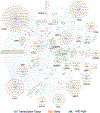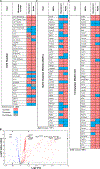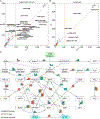Modeling cardiomyocyte signaling and metabolism predicts genotype-to-phenotype mechanisms in hypertrophic cardiomyopathy
- PMID: 38677172
- PMCID: PMC11175993
- DOI: 10.1016/j.compbiomed.2024.108499
Modeling cardiomyocyte signaling and metabolism predicts genotype-to-phenotype mechanisms in hypertrophic cardiomyopathy
Abstract
Familial hypertrophic cardiomyopathy (HCM) is a significant precursor of heart failure and sudden cardiac death, primarily caused by mutations in sarcomeric and structural proteins. Despite the extensive research on the HCM genotype, the complex and context-specific nature of many signaling and metabolic pathways linking the HCM genotype to phenotype has hindered therapeutic advancements for patients. Here, we have developed a computational model of HCM encompassing cardiomyocyte signaling and metabolic networks and their associated interactions. Utilizing a stochastic logic-based ODE approach, we linked cardiomyocyte signaling to the metabolic network through a gene regulatory network and post-translational modifications. We validated the model against published data on activities of signaling species in the HCM context and transcriptomes of two HCM mouse models (i.e., R403Q-αMyHC and R92W-TnT). Our model predicts that HCM mutation induces changes in metabolic functions such as ATP synthase deficiency and a transition from fatty acids to carbohydrate metabolism. The model indicated major shifts in glutamine-related metabolism and increased apoptosis after HCM-induced ATP synthase deficiency. We predicted that the transcription factors STAT, SRF, GATA4, TP53, and FoxO are the key regulators of cardiomyocyte hypertrophy and apoptosis in HCM in alignment with experiments. Moreover, we identified shared (e.g., activation of PGC1α by AMPK, and FHL1 by titin) and context-specific mechanisms (e.g., regulation of Ca2+ sensitivity by titin in HCM patients) that may control genotype-to-phenotype transition in HCM across different species or mutations. We also predicted potential combination drug targets for HCM (e.g., mavacamten plus ROS inhibitors) preventing or reversing HCM phenotype (i.e., hypertrophic growth, apoptosis, and metabolic remodeling) in cardiomyocytes. This study provides new insights into mechanisms linking genotype to phenotype in familial hypertrophic cardiomyopathy and offers a framework for assessing new treatments and exploring variations in HCM experimental models.
Keywords: Cardiac metabolism; Cardiac signaling; Genotype-to-phenotype; Hypertrophic cardiomyopathy; Network modeling; Systems biology.
Copyright © 2024 Elsevier Ltd. All rights reserved.
Conflict of interest statement
Declaration of competing interest The authors declare no competing interests.
Figures







Similar articles
-
Signaling network model of cardiomyocyte morphological changes in familial cardiomyopathy.J Mol Cell Cardiol. 2023 Jan;174:1-14. doi: 10.1016/j.yjmcc.2022.10.006. Epub 2022 Nov 10. J Mol Cell Cardiol. 2023. PMID: 36370475 Free PMC article.
-
Muscle LIM Protein Force-Sensing Mediates Sarcomeric Biomechanical Signaling in Human Familial Hypertrophic Cardiomyopathy.Circulation. 2022 Apr 19;145(16):1238-1253. doi: 10.1161/CIRCULATIONAHA.121.056265. Epub 2022 Apr 6. Circulation. 2022. PMID: 35384713 Free PMC article.
-
Differences in molecular phenotype in mouse and human hypertrophic cardiomyopathy.Sci Rep. 2021 Jun 23;11(1):13163. doi: 10.1038/s41598-021-89451-6. Sci Rep. 2021. PMID: 34162896 Free PMC article.
-
The molecular genetic basis for hypertrophic cardiomyopathy.J Mol Cell Cardiol. 2001 Apr;33(4):655-70. doi: 10.1006/jmcc.2001.1340. J Mol Cell Cardiol. 2001. PMID: 11273720 Free PMC article. Review.
-
Abnormalities in sodium current and calcium homoeostasis as drivers of arrhythmogenesis in hypertrophic cardiomyopathy.Cardiovasc Res. 2020 Jul 15;116(9):1585-1599. doi: 10.1093/cvr/cvaa124. Cardiovasc Res. 2020. PMID: 32365196 Review.
Cited by
-
Deciphering Oxidative Stress in Cardiovascular Disease Progression: A Blueprint for Mechanistic Understanding and Therapeutic Innovation.Antioxidants (Basel). 2024 Dec 31;14(1):38. doi: 10.3390/antiox14010038. Antioxidants (Basel). 2024. PMID: 39857372 Free PMC article. Review.
-
DynProfiler: a Python package for comprehensive analysis and interpretation of signaling dynamics leveraged by deep learning techniques.Bioinform Adv. 2024 Oct 7;4(1):vbae145. doi: 10.1093/bioadv/vbae145. eCollection 2024. Bioinform Adv. 2024. PMID: 39391633 Free PMC article.
-
Redox Homeostasis and Molecular Biomarkers in Precision Therapy for Cardiovascular Diseases.Antioxidants (Basel). 2024 Sep 25;13(10):1163. doi: 10.3390/antiox13101163. Antioxidants (Basel). 2024. PMID: 39456418 Free PMC article. Review.
References
-
- Semsarian C, Ingles J, Maron MS & Maron BJ New perspectives on the prevalence of hypertrophic cardiomyopathy. J. Am. Coll. Cardiol. 65, 1249–1254 (Mar. 2015). - PubMed
-
- Maron Barry J et al. Diagnosis and Evaluation of Hypertrophic Cardiomyopathy. J. Am. Coll. Cardiol. 79, 372–389 (Feb. 2022). - PubMed
-
- Kimura A Molecular genetics and pathogenesis of cardiomyopathy. J. Hum. Genet. 61, 41–50 (Jan. 2016). - PubMed
-
- O’Mahony C, Elliott P & McKenna W Sudden cardiac death in hypertrophic cardiomyopathy. Circ. Arrhythm. Electrophysiol. 6, 443–451 (Apr. 2013). - PubMed
Publication types
MeSH terms
Grants and funding
LinkOut - more resources
Full Text Sources
Other Literature Sources
Research Materials
Miscellaneous

